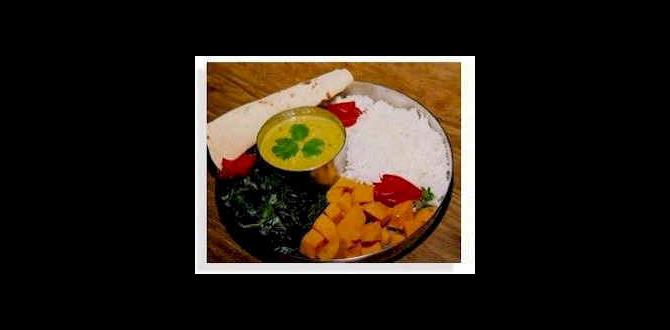Quick Summary: Ordering food at a restaurant abroad? Tipping etiquette varies worldwide! This guide simplifies global restaurant tipping, offering clear percentages and cultural insights for a smooth dining experience. Explore essential tips to dine confidently anywhere you go.
Ever found yourself staring at the bill in a foreign restaurant, a little unsure about how much to leave? You’re not alone! Tipping can feel like a tricky dance, especially when you travel. What’s standard in one country might be unexpected in another. It’s a common point of confusion that can make enjoying a delicious meal a bit stressful. But don’t worry! FoodsGuider is here to help you navigate the world of restaurant tipping with ease. We’ve put together this simple guide to make sure you feel confident and prepared, no matter where your taste buds take you. Let’s explore how to leave a tip like a local, or at least, without any awkward moments!
Understanding Global Tipping Norms: Why It Matters
Tipping is more than just leaving a few extra coins; it’s a significant part of many service workers’ income in various cultures. In some places, it’s a deeply ingrained tradition, while in others, it’s entirely optional or even frowned upon. Understanding these differences is key not just for being a polite guest, but also for appreciating the context of service and wages in different countries. Think of it as a small but important cultural exchange. By getting it right, you show respect for the local customs and the people who serve you.
The simplest way to approach tipping is to remember that it often reflects the local wage structure. In countries where service staff are paid a higher base wage, tipping is less expected. Conversely, in places where wages are lower, tips are a crucial supplement. This guide will break down these variations, giving you practical advice for dining out around the globe. We’ll cover everything from essential percentages to cultural nuances, ensuring your next meal abroad is as enjoyable for your wallet and your conscience as it is for your palate.
Tipping Etiquette by Region: A Quick Overview
Navigating tipping customs can feel like deciphering a secret code. While many places have established norms, it’s good to remember that these can shift, and personal experiences might vary. The key is to be observant and informed. For instance, in the United States, tipping is a significant part of a server’s income. In contrast, in Japan, service charges are often included, and tipping might be considered unusual. This section will give you a general map of tipping expectations across different parts of the world.
To make it easier to digest, we’ll look at some of the most common travel destinations and their tipping practices. Remember, this is a guide, and sometimes the best approach is to discreetly observe what locals do. When in doubt, a quick search or asking your hotel concierge can provide helpful, up-to-date information. Our goal is to equip you with the knowledge to feel comfortable and respectful at any restaurant, anywhere!
North America: The Land of Generous Tipping
When dining in the United States and Canada, tipping is practically an art form. Service staff in these countries typically rely on tips to make up a substantial portion of their income. This means that tipping is not just appreciated, but expected, for good service. Failing to tip, or tipping too little, can be seen as a significant slight.
United States
In the US, the standard tip for waitstaff in restaurants is generally between 15% and 20% of the pre-tax bill. For exceptional service, some diners opt to tip 25% or more. It’s customary to tip bartenders, hairdressers, taxi drivers, and hotel staff as well. When ordering at a counter or a fast-casual restaurant where you collect your own food, a smaller tip (e.g., $1-$5) is often appreciated for good service, though not always required.
Canada
Canadian tipping customs are very similar to those in the United States. A tip of 15% to 20% for restaurant servers is the norm. Bartenders usually receive 10-15% of the drink total. Other service providers like taxi drivers and hotel staff also expect tips equivalent to those in the US.
Key Points for North America:
- Tipping is a significant part of service workers’ wages.
- Aim for 15-20% for satisfactory to good service in restaurants.
- Exceptional service warrants a higher tip (20-25%+).
- Service charges are usually not included in the bill; you add the tip.
Europe: A Mosaic of Tipping Traditions
Europe presents a more varied landscape when it comes to tipping. While service charges are often included in the bill in many European countries, tipping for excellent service is still common practice in some places. It’s essential to check the bill for a “service charge” or “IVA inclusa” (VAT included) before tipping.
United Kingdom
In the UK, a service charge of 10-12.5% is often added to the bill automatically, especially in London and tourist areas. If a service charge is included, no additional tip is necessary. If it’s not included and you received good service, tipping around 10-15% is a nice gesture. For casual pubs or cafes where you order at the bar, tipping is not usually expected.
France
Service is legally included in the price of food and drinks in France (“service compris”). You are not obligated to leave a tip. However, if you enjoyed your meal and the service was outstanding, leaving a few extra euros or rounding up the bill is a polite way to show appreciation. A tip of 5-10% is considered very generous here.
Italy
Tipping in Italy is less formal than in many other countries. Some restaurants may add a “coperto” (cover charge) per person, which is not a tip but a fee for bread and service. A service charge (“servizio”) might also be included. If neither is present and you receive excellent service, rounding up the bill or leaving a few euros is a common and appreciated practice, but not mandatory. Around 5-10% is plenty.
Spain
Similar to Italy, tipping in Spain is not obligatory, especially if a service charge is already included. For good service in a restaurant, leaving small change or rounding up the bill to the nearest euro is common. If you had an exceptional experience, a slightly larger tip of 5-10% would be well-received. In bars, this is often not done.
| Country | Typical Custom | Percentage/Amount |
|---|---|---|
| United Kingdom | Service charge often included. Tip if not. | 10-15% (if service not included), or round up. |
| France | Service is included (“service compris”). | Optional, 5-10% for exceptional service (rounding up is fine). |
| Italy | “Coperto” (cover charge) or “servizio” may be included. | Optional, few euros or round up. 5-10% for excellent service. |
| Spain | Tipping not obligatory; rounding up is common. | Small change or round up to nearest euro. 5-10% is generous. |
Asia: A Diverse Spectrum of Service Charges
Asia offers a wide range of cultural norms when it comes to tipping. In some countries, it’s a customary part of the dining experience, while in others, it can be considered out of place or even insulting. Understanding these nuances is crucial to avoid any misunderstandings.
Japan
Tipping is not customary in Japan and can even be considered rude. Excellent service is expected as a standard. If you attempt to tip, the server may politely refuse or even think you are questioning their service. Instead, a polite bow and a sincere “Arigato gozaimasu” (Thank you very much) is the appropriate way to express gratitude. For a deeper dive into Japanese social graces, resources from the Government of Japan offer valuable insights into cultural etiquette.
China
In mainland China, tipping is generally not expected in restaurants. However, in tourist-heavy areas and high-end establishments, a service charge might be added. Like Japan, politeness and sincere thanks suffice. In Hong Kong, tipping is more common, with 10-15% being standard for good service, especially in tourist-oriented restaurants. Always check your bill first.
South Korea
Tipping is not a standard practice in South Korea. Service is typically included in the bill, and attempting to tip may cause confusion. A simple “Kamsahamnida” (Thank you) is the appropriate expression of appreciation for good service.
Thailand
Tipping is not mandatory in Thailand, but it is greatly appreciated, especially in tourist destinations. A small tip of around 5-10% or simply rounding up the bill is common for good service in restaurants. In more upscale establishments, a service charge may be included, so check your bill carefully.
Key Distinctions in Asia:
- Japan and South Korea: Tipping is generally not expected and can be seen as impolite.
- China (Mainland): Tipping is not customary; always check for a service charge.
- Hong Kong: Tipping (10-15%) is more common.
- Thailand: Appreciated but not mandatory; 5-10% or rounding up is common.
South America: Varying Expectations
South America, like other continents, has a diverse range of tipping customs. While service staff often appreciate extra gratuity, the amount and expectation can differ significantly from country to country.
Brazil
In Brazil, a “taxa de serviço” (service charge) of 10% is often automatically added to the bill in restaurants. It’s usually optional, and you can ask for it to be removed if the service was poor. If it’s not included, a 10% tip for good service is customary. Be aware that some restaurants automatically add this charge for all customers.
Argentina
Tipping is customary but not mandatory in Argentina. A tip of about 10% is common for good table service in restaurants. You usually pay this in cash directly to your server. It’s separate from the “cubierto” (cover charge) that some restaurants may add for bread and patrons.
Peru
Tipping 10% is customary in Peru for good service in restaurants, especially in tourist areas. It’s usually added to the bill, but if it’s not, you can add it yourself or leave cash. In smaller, local eateries, less emphasis is placed on tipping.
It’s always a good idea to check your bill. If a service charge is already included, you are generally not expected to leave an additional tip unless the service was truly exceptional. For local, inexpensive eateries, rounding up into the change is often sufficient.
Oceania: Generally Less Formal Tipping
Australia and New Zealand generally have higher base wages for hospitality staff, meaning tipping is not a significant part of income and is therefore not expected in the same way as in North America.
Australia
Tipping is not a widespread custom in Australia. Many people do not tip at all. If you receive truly outstanding service, a small tip of 5-10% is appreciated but not required. Some establishments might include a service charge for large groups or on public holidays, but this is not the norm for everyday dining.
New Zealand
Similar to Australia, tipping is generally not expected in New Zealand. Service staff are paid an adequate wage, so there’s no cultural obligation to tip. If you feel the service was exceptional, you can choose to leave a small tip (around 5-10%), but it is entirely at your discretion and not anticipated.
The focus in Oceania is more on the quality of the service itself rather than an expectation of additional gratuity. A genuine “thank you” is often considered sufficient acknowledgment.
Other Regions & Unique Situations
Beyond the major continents, tipping customs can continue to vary. Understanding these can save you from awkward moments and ensure you’re being respectful.
Middle East
Tipping practices in the Middle East can be quite varied. In countries like the United Arab Emirates (including Dubai), a 10-15% service charge is often included in bills, and additional tipping is appreciated but not strictly mandatory. In other countries within the region, tipping around 5-15% is common for good service, with cash often preferred. Always check your bill for any included service charges.
Africa
Service staff in many African countries, particularly in tourist areas, are accustomed to receiving tips. A 10% service charge might be added to bills in hotels and restaurants. If not, tipping 10-15% for good service is customary. In more local, less tourist-oriented establishments, tipping may be less expected but still appreciated.
Cruise Ships
Cruise ships often have their own tipping systems. Many cruise lines automatically add a daily gratuity charge to your onboard account for dining, housekeeping, and other services. You can usually adjust this amount based on your satisfaction. It’s wise to check the specific cruise line’s policy before your trip.
Special Considerations:
- Buffets: For buffet-style dining, a smaller tip (e.g., 5-10%) is generally sufficient, as servers often have more tables to attend to or their role is more focused on clearing plates rather than full table service.
- Takeaway/Delivery: Tipping for takeaway orders is less common in many countries, but a few coins or rounding up the bill can be a nice gesture if the service was efficient and friendly. For delivery drivers, a small tip is appreciated in most regions.
- Private Tours/Guides: For private tours or personal guides, tipping is often expected, with amounts varying based on the length of the service and the quality.
When to Adjust Your Tip
The general percentages are a great starting point, but tipping isn’t always a rigid rule. Your tip should reflect your dining experience. If the service was outstanding—attentive, friendly, and efficient—consider tipping on the higher end of the suggested range, or even exceeding it. A server who went above and beyond deserves recognition!
On the flip side, if the service was poor due to factors within the server’s control (e.g., rudeness, inattentiveness, errors), you have the discretion to reduce the tip. However, it’s generally advisable to speak to the manager about any significant issues before deciding on a reduced tip. Sometimes, a mistake can be rectified, and a conversation can resolve the issue more constructively than simply leaving a smaller amount without explanation. Remember to differentiate between poor service and unavoidable issues like a long wait for food due to a busy kitchen or an incorrect order from the chef.
How to Calculate Tips Accurately
Calculating tips can sometimes feel like a mini math test, especially when trying to figure out percentages on the fly. Here are some simple methods to make it easy:
Using a Calculator
Most smartphones have a built-in calculator. You can find the total amount by multiplying the bill amount by your desired percentage (e.g., for a $50 bill and a 18% tip: $50 * 0.18 = $9). This is the most accurate method.
Mental Math Tricks
For 10% Tip: Simply move the decimal point one place to the left on the bill amount. For a $50 bill, 10% is $5.
For 20% Tip: Calculate 10% and then double it. For a $50 bill, 10% is $5, so 20% is $10.
For 15% Tip: Calculate 10% and add half of that amount. For a $50 bill, 10% is $5. Half of that is $2.50. So, 15% is $5 + $2.50 = $7.50.
Rounding Up
In many countries where tipping is less mandatory, simply rounding the bill up to the nearest convenient amount is a common and polite gesture. If your bill comes to $37.50, you might pay $40 and consider the extra $2.50 your tip.
Pre-Tax vs. Post-Tax Tip
In countries like the US, tips are generally calculated on the pre-tax amount. This avoids tipping on the taxes themselves, which is an unnecessary expense. For instance, if your bill is $100 with $10 in tax, making the total $110, a 20% tip would be $20 (based on the $100 pre-tax amount), not $22.




